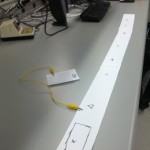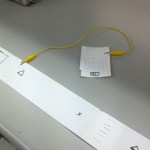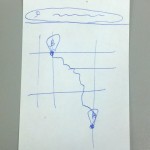Group 11 – Don’t Worry About It
Krithin, Amy, Daniel, Jonathan, Thomas
Mission Statement
Our purpose of building the NavBelt is to make navigating cityscapes safer and more convenient. People use their mobile phones to find directions and navigate through unfamiliar locations. However, constantly referencing a mobile phone with directions distracts the user from safely walking through obstacles and attracts unwanted attention. From our first low-fidelity, we hope to learn how best to give feedback to the user in a haptic manner so they can navigate more effectively. Such will include how long to vibrate, where to vibrate, and when to signal turns.
Krithin Sitaram (krithin@) – Hardware Expert
Amy Zhou (amyzhou@) – Front-end Expert
Daniel Chyan (dchyan@) – Integration Expert
Jonathan Neilan (jneilan@) – Human Expert
Thomas Truongchau (ttruongc@) – Navigation Expert
We are opening the eyes of people to the world by making navigation safer and more convenient by keeping their heads held high.
The Prototype
The prototype consists of a paper belt held together by staples and an alligator clip. Another alligator clip connects the NavBelt prototype to a mock mobile phone made of paper. The x’s and triangles mark where the vibrating elements will be placed. For clarity, the x’s mark forwards, backwards, left, and right while the triangles mark the directions in between the other four.
- Entirety of the NavBelt (X’s and Triangles indicate placement of vibrating motors.)
- Screen that User Uses to Input Destination
- Interface for User to Confirm Destination
The Tasks
1. Identifying the correct destination (Easy Task)
2. Provide information about immediate next steps. (Hard Task)
3. Reassure user is on the right path. (Moderate Task)
Method
1. The user types his destination into his mobile phone, and verifies using a standard map interface that the destination has been correctly identified an appropriate route to it has been found.
2. One of the actuators on the NavBelt will constantly be vibrating to indicate the direction the user needs to move in; we simulated this by having one of our team repeatedly poke the user with a stapler at the appropriate point on the simulated belt. Vibration of one of the side actuators indicates that the user needs to make a turn at that point.
The following video shows how a normal user would use our prototype system to accomplish tasks 1 and 2. Observe that the user first enters his destination on his phone, then follows the direction indicated by the vibration on the belt.
http://www.youtube.com/watch?v=oeiPrTMWa0c&edit=vd
The following video demonstrates that the user truly can navigate solely based on the directions from the belt. Observe that the blindfolded user here is able to follow the black line on the floor using only feedback from the simulated belt.
http://www.youtube.com/watch?v=2ByxGkh11FA&edit=vd
3. In order to reassure the user that he or she is on the correct path, the NavBelt will pulsate in the direction of the final destination; if the actuator at the user’s front is vibrating that is reassurance that the user is on the right track. Again, a tester with a stapler will poke at one of the points on the belt to simulate the vibration.
http://www.youtube.com/watch?edit=vd&v=cH1OzO-7Swc
Discussion
We constructed the prototype from strips of paper and alligator clips to hold the belt together and to represent the connection between the mobile phone and the NavBelt. We also used a stapler to represent the vibrations that would direct the user where to walk. We encountered no real difficulties and the prototype was effective for guiding a user between two points.



